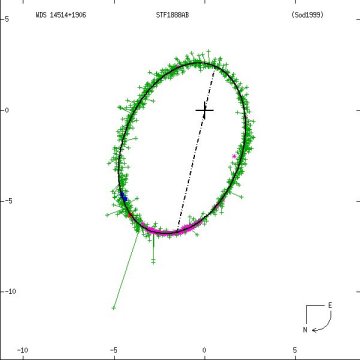
 |
Xi Bootis B goes around Xi Boo A (the brighter and more massive of the two, placed at the cross) in the clockwise direction with an orbital period of 151.6 years at an average separation of 33.5 Astronomical Units. In reality, both go around each other. North is down, and the scale around the edges is in seconds of arc. The dot-dash line is the orbit's major axis. The orbital plane is tilted to the line of sight by 41 degrees, so that Xi Boo A does not appear at the focus of the orbit (where it actually is). Binaries like this one are critical in the determination of stellar masses. (From W. I. Hartkopf and B. D. Mason, Sixth Catalog of Orbits of Visual Binary Stars, U. S, Naval Observatory.) |